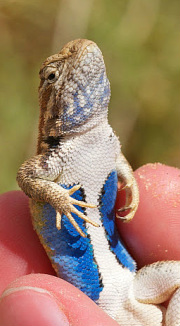Sagebrush Lizard
Sceloporous graciosus
Click here for the full photo gallery for this species!
|
General Distribution: Extremely wide distribution: Washington, Idaho, Montana, and western North Dakota, south to Baja California, central Arizona and northeastern New Mexico.
Colorado Distribution: Throughout western slope from Wyoming to New Mexico. County color codes: Blue = known historic occurrence, Yellow = unconfirmed but possible/likely occurrence, Gray = unlikely to occur.
Conservation Status: Nongame in Colorado. NatureServe rank: G5 (Globally Secure), S5 (State Secure). General threats to conservation include habitat loss and fragmentation.
|
Diagnostic Features:
Coloration/Markings: Dorsal color grayish to brownish with a pale dorsolateral stripe on each side. Each side of pale stripe bordered by a series of irregularly shaped darker brown blotches extending to the base of the tail. Adult males have blue belly patches and generally some light blue mottling or streaking on throat. Adult females have faint or absent blue belly patches. When gravid, females develop orange coloration from their throat, along their sides, and onto the tail. |
Adult male Sagebrush Lizard. Wayne County, Utah.
|
Size: Average size of adults in Colorado is 56 mm (2.2 in) snout-vent length (Deslippe and M’Closkey 1991) and females reach a larger maximum size than males. Hatchlings are about 23-28 mm (0.9-1.1 in) snout-vent length (Douglas 1966).
Habitat: In Colorado habitats include pinõn-juniper, semidesert shrubland, mountain shrubland, and montane woodland. Regardless of major habitat type it generally occurs on the ground on fine-grained soils. It often co-occurs with the Plateau Lizard (Sceloporus tristichus) at mid-elevations but is often the only sceloporine at higher elevations.
Activity: April through September. Diurnal.
Reproduction: Most females in Colorado produce two clutches of eggs per year (Turner 1974). Clutch sizes are small compared to Plateau and Prairie Lizards, averaging 4-5 eggs (Turner 1974). Hatchings appear late July to mid-September (Turner 1974).
Feeding & Diet: Insectivorous with ants predominating. A sit-and-wait predator.
Defenses from Predation: Cryptic behavior and coloration but always near cover. Flees for cover when closely approached.
Habitat: In Colorado habitats include pinõn-juniper, semidesert shrubland, mountain shrubland, and montane woodland. Regardless of major habitat type it generally occurs on the ground on fine-grained soils. It often co-occurs with the Plateau Lizard (Sceloporus tristichus) at mid-elevations but is often the only sceloporine at higher elevations.
Activity: April through September. Diurnal.
Reproduction: Most females in Colorado produce two clutches of eggs per year (Turner 1974). Clutch sizes are small compared to Plateau and Prairie Lizards, averaging 4-5 eggs (Turner 1974). Hatchings appear late July to mid-September (Turner 1974).
Feeding & Diet: Insectivorous with ants predominating. A sit-and-wait predator.
Defenses from Predation: Cryptic behavior and coloration but always near cover. Flees for cover when closely approached.
Cited & Additional Resources
- Degenhardt, W. G., C. W. Painter and A. H. Price.1996. Amphibians and reptiles of New Mexico. University of New Mexico Press, Albuquerque, New Mexico. 431 pp.
- Deslippe R.J. and R.T. M’Closkey 1991. An experimental test of mate defense in an iguanid lizard (Sceloporus graciosus). Ecology 72:218-224.
- Hammerson, G. A. 1999. Amphibians and reptiles in Colorado. 2nd ed. University Press of Colorado, Boulder, Colorado. 484 pp.
- Turner W.T. 1974. Ecological relationships between two sympatic species of Sceloporus lizards. M.S. thesis Colorado State University, Fort Collins.
Account compiled by: Tom Mathies
Reviewed by: Lauren Livo
Last updated: 4/14/2022 by Rémi Pattyn
Suggested Citation
Colorado Partners in Amphibian and Reptile Conservation. 2014. Species account for the Sagebrush Lizard (Sceloporus graciosus). Compiled by Tom Mathies. http://www.coparc.org/sagebrush-lizard.html [accessed date here].
Reviewed by: Lauren Livo
Last updated: 4/14/2022 by Rémi Pattyn
Suggested Citation
Colorado Partners in Amphibian and Reptile Conservation. 2014. Species account for the Sagebrush Lizard (Sceloporus graciosus). Compiled by Tom Mathies. http://www.coparc.org/sagebrush-lizard.html [accessed date here].



